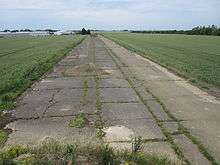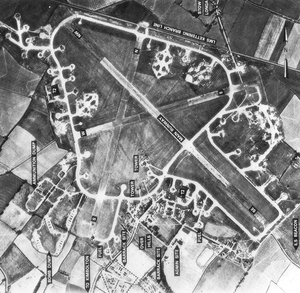RAF Kimbolton
| RAF Kimbolton USAAF Station 117 .png) | |
|---|---|
| Located Near Huntingdon, Cambridgeshire, England | |
|
Aerial Photo of Kimbolton Airfield - 10 August 1945 | |
 RAF Kimbolton Map showing the location of RAF Kimbolton within Cambridgeshire. | |
| Coordinates | 52°18′53″N 0°22′59″W / 52.31472°N 0.38306°WCoordinates: 52°18′53″N 0°22′59″W / 52.31472°N 0.38306°W |
| Type | Royal Air Force station |
| Code | KI |
| Site information | |
| Owner | Air Ministry |
| Controlled by | United States Army Air Forces |
| Site history | |
| Built | 1941 |
| In use | 1942-1946 |
| Battles/wars |
European Theatre of World War II Air Offensive, Europe July 1942 - May 1945 |
| Garrison information | |
| Garrison | Eighth Air Force |
| Occupants | 379th Bombardment Group |
RAF Kimbolton is a former Royal Air Force station located 8 miles (13 km) west of Huntingdon, Cambridgeshire, England.
History
USAAF use
The airfield was originally built in 1941 for RAF Bomber Command, then expanded to Class A airfield standards for use by American heavy bombers during 1942. Kimbolton was assigned to the United States Army Air Forces (USAAF) Eighth Air Force. It was given the designation USAAF Station 117.
91st Bombardment Group (Heavy)
The airfield was opened in 1942 and was first used by the USAAF Eighth Air Force 91st Bombardment Group (Heavy), arriving from Walla Walla AAF, Washington during September.
The 91st was assigned to the 1st Combat Bombardment Wing of the 1st Bombardment Division. Its tail code was Triangle-A. Its operational Boeing B-17 Flying Fortress squadrons were:
- 322d Bombardment Squadron (LG)
- 323d Bombardment Squadron (OR)
- 324th Bombardment Squadron (DF)
- 401st Bombardment Squadron (LL)
The 91st stayed at Kimbolton only a few weeks, because the runways at Kimbolton were not strong or long enough for the safe operation of Fortresses. The group transferred to RAF Bassingbourn on 14 October.
17th Bombardment Group (Medium)
The next USAAF unit to use Kimbolton was the 17th Bombardment Group (Medium), arriving in October from Barksdale AAF Louisiana. The 17th was originally intended to use RAF Bassingbourn. However, with the move of the 91st, the unit utilized Kimbolton as its shorter runways could accommodate their smaller, twin-engined medium bombers.
The 17th consisted of the following squadrons:
- 34th Bombardment Squadron
- 37th Bombardment Squadron
- 95th Bombardment Squadron
- 432d Bombardment Squadron
The 17th flew the Martin B-26 Marauder medium bomber, and used Kimbolton as a transitory airfield on its way to the North African campaign. The Group departed in November for Telergma, Algeria, with its last elements leaving in early December. With the departure of the B-26s, extensions were made to the NW-SE runway to facilitate the operation of fully loaded B-17s.
379th Bombardment Group (Heavy)




On 21 May 1943, the 379th Bombardment Group (Heavy) arrived from Sioux City AAF, Iowa.
The 379th was assigned to the 41st Combat Bombardment Wing of the 1st Bombardment Division. Its tail code was Triangle-K. Its operational B-17 Flying Fortress squadrons were:
- 524th Bombardment Squadron (WA)
- 525th Bombardment Squadron (FR)
- 526th Bombardment Squadron (LF)
- 527th Bombardment Squadron (FO)
The 379th BG began operations with Eighth AF on 19 May 1943, and received a Distinguished Unit Citation for operations over Europe from May 1943 through July 1944. The group engaged primarily in bombardment of strategic targets such as industries, oil refineries, storage plants, submarine pens, airfields and communications centres in Germany, France, the Netherlands, Belgium, Norway and Poland.
Specific targets included a chemical plant in Ludwigshafen, an aircraft assembly plant in Brunswick, ball-bearing plants at Schweinfurt and Leipzig, synthetic oil refineries at Merseburg and Gelsenkirchen, marshalling yards at Hamm and Reims and airfields in Mesnil au Val and Berlin.
The Group received another DUC for flying without fighter protection into central Germany to attack vital aircraft factories on 11 January 1944. On several occasions the Group attacked interdictory targets and operated in support of ground forces. It bombed V-weapon sites, airfields, radar stations and other installations before the Normandy invasion in June 1944, bombed defended positions just ahead of the Allied landings on 6 June and struck airfields, rail choke points, and gun emplacements during the campaign that followed.
During the Battle of France, the Group bombed enemy positions to assist ground troops at St Lo during the breakthrough, 24–25 July 1944, attacked German communications and fortifications during the Battle of the Bulge, December 1944 - January 1945, and bombed bridges and viaducts in France and Germany to aid the Allied assault across the Rhine, February–March 1945.
The combat record of the 379th was the most successful of all the Eighth Air Force heavy bomber groups. It held records as far as bomb tonnage dropped - 26,459 tons - more than any other unit including those operational before the 379th arrived in the UK. It also exceeded all other UK Bomb Groups in the total number of missions flown, carrying out 330 between May 1943 and 15 May 1945. Two of the 524th Squadron B-17's claimed individual fame: "Ole Gappy", completed 157 missions, probably more than any other Eighth Air Force bomber and "Swamp Fire" was the first heavy bomber to achieve 100 missions without an abort. Lt Bruce E. Mills was the pilot of that mission.
After V-E Day, the 379th Bomb Group was transferred to Casablanca, French Morocco, during June 1945. The unit was inactivated in Morocco during July.
Legacy
The 379th Bomb Wing and 524th Bomb Squadron were reactivated by Strategic Air Command and requipped with Boeing B-47 Stratojet medium bombers at Homestead AFB, Florida, on 1 November 1955. Upon activation, the unit was bestowed the honors, history and colors of the World War II Eighth Air Force's 379th Bomb Group. In January 1961, the wing was redesignated as a heavy bombardment wing and relocated to Wurtsmith AFB, Michigan where it was equipped with Boeing B-52 Stratofortress and KC-135 Stratotanker aircraft. Throughout the Cold War, the wing played a major role in the defense of the United States.
Post Second World War
The wing meritoriously served in combat during the Vietnam War and 1990-1991 Operations Desert Shield/Operation Desert Storm flying the Boeing B-52G Stratofortress (the vertical stabilizer of the 379th's aircraft were emblazoned with the Triangle K to honor their Second World War namesake). Wurtsmith AFB, named after Major General Paul B. Wurtsmith was closed by BRAC action in 1993 and the 379th Bombardment Wing was disestablished the same year.
In 2003, the 379th was reactivated in provisional status as the 379th Air Expeditionary Wing (379 AEW) of the Air Combat Command, assigned to Al Udeid Air Base, Qatar.
Postwar military use

After the Second World War, Kimbolton was closed in 1946 but maintained in a "standby" status until the early 1960s. After the Americans left the RAF used the base for basic training(square bashing). Many hundreds of conscripts did their basic training there before it was closed.
Current use
With the end of military control, most of the buildings were torn down and the concrete areas removed. However, parts of the old hardstands are used for go-kart racing since 1950. The kart club's flag is the 379th "Triangle K" symbol. In one of the buildings at the kart track there is a collection of memorabilia including photographs and pieces of aircraft wreckage. Once a month, MSA Kart Race Meetings are held there.
Today, the B-road which connects the village of Stow Longa to the town of Kimbolton crosses over the remains of RAF Kimbolton's main runway. The crumbling concrete is visible just past the shoulder of the road. Additionally, a public footpath crosses the main area where the control tower once stood, the foundations of which are still recognizable among the farmland.[1]
On weekends, "banger racing" was formerly held on one of the old loop hardstands.
See also
References
![]() This article incorporates public domain material from the Air Force Historical Research Agency website http://www.afhra.af.mil/.
This article incorporates public domain material from the Air Force Historical Research Agency website http://www.afhra.af.mil/.
Citations
- ↑ http://cambridgemilitaryhistory.com/tag/raf-kimbolton/ RAF Kimbolton page on www.cambridgemilitaryhistory.com
Bibliography
- Freeman, Roger A. (1978) Airfields of the Eighth: Then and Now. After the Battle ISBN 0-900913-09-6
- Freeman, Roger A. (1991) The Mighty Eighth The Colour Record. Cassell & Co. ISBN 0-304-35708-1
- Maurer, Maurer (1983). Air Force Combat Units Of World War II. Maxwell AFB, Alabama: Office of Air Force History. ISBN 0-89201-092-4.
- www.controltowers.co.uk Kimbolton
- mighty8thaf.preller.us Kimbolton
- USAAS-USAAC-USAAF-USAF Aircraft Serial Numbers--1908 to present
- Home Of The Swamp Fire Website
External links
| Wikimedia Commons has media related to RAF Kimbolton. |
- Kimbolton History Section website
- 379th BG personal website
- 379th Bomb Group Association Website
- Wurtsmith Air Force Base Historical Website
- Home Of The Swamp Fire Website
- RAF Kimbolton page on the Cambridge Military History Website
